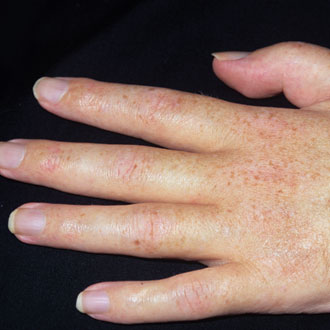A 57-year-old builder presented to his GP in August with difficulty straightening the fingers on his right hand.
There was some swelling of the metacarpophalangeal joint in the thumb and an X-ray showed mild osteoarthritis.
He was referred to orthopaedics but over the following months his symptoms progressed, and he became increasingly clumsy with his hands and a little unsteady on his feet.
By October, he had reduced power in T1, C8, and C9 distributions. He had a normal neurological examination in the lower limbs, although he struggled to heel-toe walk. An X-ray showed some degeneration in his cervical spine and an MRI was requested, but his symptoms continued to progress and an urgent neurological opinion was sought at the end of October.
By then, he had bilateral claw hands and wasting in his arms and thighs and the small muscles of both hands. He denied dysphagia, but on examination he had some early bulbar speech, a brisk jaw jerk and difficulty whistling, in keeping with mild facial weakness.
Nerve conduction studies, MRI and pulmonary function were all arranged to exclude key differential diagnoses but motor neurone disease (MND) was confirmed.
The problem
MND is rare, with an incidence of two per 100,000 per year and a prevalence of approximately seven per 100,000. Men are affected twice as often as women and most new cases occur in middle life between the ages of 50-70, although it can present at any age.
Diagnostic delay can occur because it is so rare and because the early symptoms, such as mild weakness, loss of co-ordination and speech disorder, are subtle and can be generic to many conditions. MND must be considered in any patient with progressive painless weakness.
Features
Some 70% of patients have limb involvement on presentation, but these are often subtle, leading to a loss of manual dexterity or simple trips and falls. Many patients are inappropriately referred to orthopaedics in the first instance, as with the case study. A quarter of patients will have bulbar symptoms on presentation, with a subtle dysarthria or softening of their voice, especially when tired. A dysphagia to solids and liquids is often described, but sometimes symptoms are more subtle and there is simply an excessive amount of saliva or a sensation of choking when lying flat.
The presentation is dependent on which of the four main types of MND is involved and what the overlap is.
Amyotrophic lateral sclerosis (ALS)
The most common form of MND. Muscle atrophy occurs due to disease in the lateral corticospinal tracts. People who have this form of the disease often develop a progressive weakness and wasting in their arms and legs.
Progressive bulbar and pseudobulbar palsy (PBP)
A mixed upper motor neurone and lower motor neurone picture affecting the cranial nerves can lead to more prominent bulbar symptoms.
Progressive muscular atrophy (PMA)
Affected individuals may notice weakness or clumsiness in their hands due to wasting of the small muscles.
Primary lateral sclerosis (PLS)
A rare form of MND. Upper motor neurones are predominantly affected, and weakness in both lower and upper limbs can be associated with weak palates, as seen in PBP.
Diagnosis and treatment
There is no specific diagnostic test for MND, although denervation picked up by neurophysiological studies such as EMG helps to exclude other conditions that resemble MND. The course for most individuals leads to death, with a mean survival of 30 months depending on subtype. Survival beyond three to five years is highly unusual.1
The use of riluzole, a sodium-channel blocker that inhibits glutamate release, has been assessed through a Cochrane review in patients with ALS.2 The review indicated that riluzole 100mg probably prolongs median survival in people with ALS by two to three months. There was a small beneficial effect on both bulbar and limb function, but not on muscle strength. There is also now good evidence for non-invasive ventilation in improving survival and quality of life.3 Both riluzole and non-invasive ventilation for treatment of MND are endorsed by NICE.4,5
Patients with MND need a multidisciplinary team approach to manage their many and varied symptoms – this is usually managed through regional care centres. GPs have a crucial role as co-ordinators between regional centres and local services. The Motor Neurone Disease Association (MNDA) has excellent resources to support patients and doctors.
With disease-modifying therapies now available, along with evidence for improved survival with good symptom management from the early stages, there is a strong clinical argument for prompt diagnosis. In addition, many patients are aware something is wrong but are unable to access the excellent support available through care centres and the MNDA until they have a firm diagnosis.
Resources for GPs
The RCGP rare diseases clinical priority programme is working closely with the MNDA to produce a red flags resource for GPs. The Healthtalkonline website (healthtalkonline.org) illustrates the experiences of patients who have developed MND. These include difficulty with speech and swallowing and the need for intervention. The MNDA website has guidance, providing a comprehensive account of how MND can affect those diagnosed and includes links to support networks.
Dr Imran Rafi is RCGP clinical champion for rare diseases
Dr Lucy Davies is a GP and clinical support fellow for the rare disease project
This article was commissioned in conjunction with the Primary Care Neurology Society
References

















